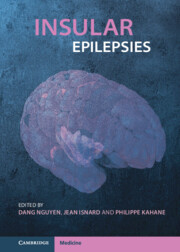Book contents
- Insular Epilepsies
- Insular Epilepsies
- Copyright page
- Contents
- Contributors
- Foreword
- Chapter 1 A Brief History of Insular Cortex Epilepsy
- Section 1 The Human Insula from an Epileptological Standpoint
- Section 2 The Spectrum of Epilepsies Involving the Insula
- Section 3 Noninvasive Investigation of Insular Epilepsy
- Section 4 Invasive Investigation of Insular Epilepsy
- Section 5 Surgical Management of Insular Epilepsy
- Index
- References
Chapter 1 - A Brief History of Insular Cortex Epilepsy
Published online by Cambridge University Press: 09 June 2022
- Insular Epilepsies
- Insular Epilepsies
- Copyright page
- Contents
- Contributors
- Foreword
- Chapter 1 A Brief History of Insular Cortex Epilepsy
- Section 1 The Human Insula from an Epileptological Standpoint
- Section 2 The Spectrum of Epilepsies Involving the Insula
- Section 3 Noninvasive Investigation of Insular Epilepsy
- Section 4 Invasive Investigation of Insular Epilepsy
- Section 5 Surgical Management of Insular Epilepsy
- Index
- References
Summary
The insula was described more than two centuries ago, in 1809, by the anatomist Johann Christian Reil. However, the functional anatomy of the insular cortex and the importance of the insula in psychiatric and neurologic pathological conditions remained obscure for a long period after the initial description of Reil. The location and the complex functional organization of the insula explain, for instance, the difficulty researchers and clinicians had in defining its contribution in temporal lobe epilepsy. This introductory chapter reviews the important steps that led to a better understanding of the role of the insula in human focal epilepsy.
Information
- Type
- Chapter
- Information
- Insular Epilepsies , pp. 1 - 10Publisher: Cambridge University PressPrint publication year: 2022
